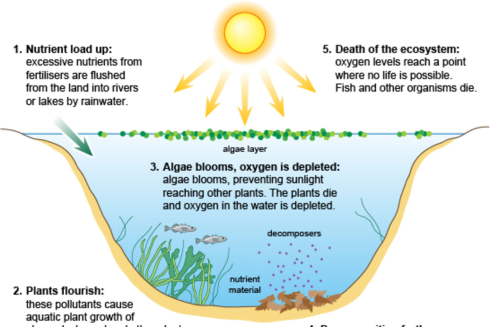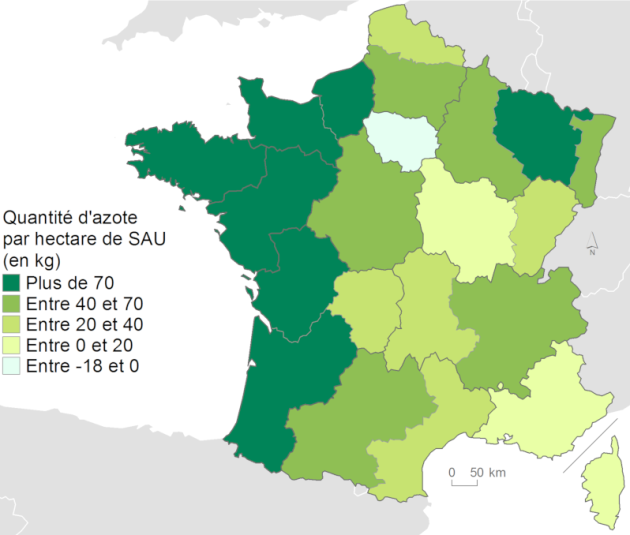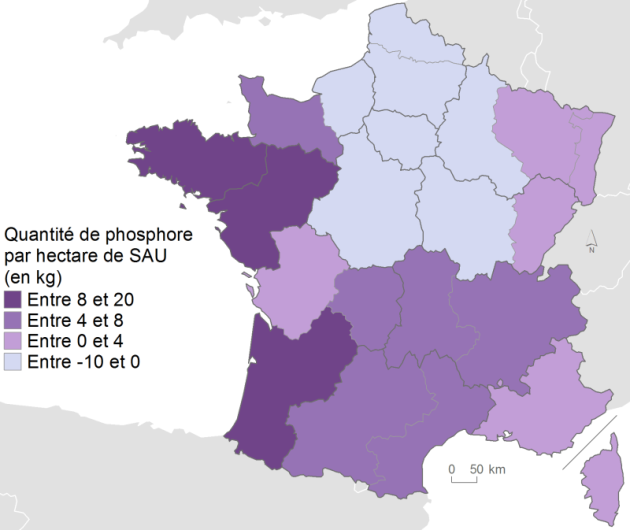Planetary boundary 3: Disruption of biogeochemical cycles
Objectives
Understand the functioning of nitrogen and phosphorus cycles and the impacts associated with their disruption.
Introduction
Nitrogen and phosphorus are essential elements for life. As a result of human activities, their biogeochemical cycle is disrupted, which can cause heavy damage to the environment (anoxia of the oceans, eutrophication of continental freshwater, proliferation of green algae, etc.). The damage caused by nitrogen and phosphorus are generally seen as regional rather than global problems. However, as part of the work on the nine planetary boundaries, an overall threshold was defined for each of the two biogeochemical cycles of nitrogen and phosphorus.
Définition : Eutrofication
Eutrophication: Process by which nutrients accumulate in an environment and alter its quality.

About nitrogen cycle
Nitrogen is an essential nutrient for plant growth. Reactive nitrogen, emitted in abundance in the environment, can however constitute a surplus compared to the needs of the plants. It then contributes to the pollution of water by nitrates. Associated with other nutrients such as phosphate, and depending on particular physicochemical conditions, it is responsible for the phenomenon of eutrophication. The main sources of nitrogen emissions into the environment are nitrogen fertilizers and the combustion of fossil resources and industrial processes. Nitrogen from polluting emissions of nitrogen oxides (NOx) to the atmosphere from transport and industry is not included in the global limit.
The challenge is to prevent an excessive release of reactive nitrogen into water and natural aquatic environments in order to prevent their eutrophication. The threshold not to be exceeded has been set between 62 and 82 million tonnes (Mt) per year, i.e. 41 to 55 kg of excess nitrogen (surplus) per hectare per year (kg / ha / year) on average at the global scale. In 2015, nitrogen losses to the environment are estimated at 150 Mt.
About phosphorus cycle
Like nitrogen, phosphorus is also an essential nutrient for plant growth. The modification of its biogeochemical cycle, caused by agriculture (fertilizers, livestock manure) and urban wastewater (excrement and detergents), affects the ability of the biosphere to sequester it and leads to eutrophication of fresh water.
The challenge initially envisaged was to prevent a major ocean anoxic event from occurring (an episode of strong reduction of oxygen in the oceans) with impacts on marine ecosystems. During the revision of the conceptual model in 2015, a two-level geographic approach is proposed.
Globally (asphyxiation of the oceans), the threshold is estimated at 11 Mt per year of phosphorus released into water (agricultural surplus and insufficiently purified wastewater). In 2015, it was exceeded with 22 Mt of phosphorus actually released into the water.
At a more localized level, an additional threshold is defined to address eutrophication of inland freshwater. This threshold relates to the phosphorus surplus resulting from excessive inputs during the fertilization of agricultural soils. These phosphorus surpluses must not exceed, each year, a range of between 6.2 and 11.2 Mt (i.e. 4.1 to 7.5 kg / ha / year) to avoid Eutrophication of water systems. pure water. In 2015, the limit was crossed with around 14 Mt.
Situation in France
In France, the excessive supply of nitrogen and phosphorus, mainly from agricultural activity for the first, and from urban wastewater for the second, corresponds to the surplus in the environment, to discharges at sea and in fresh water, which can lead locally to eutrophication phenomena and the proliferation of green algae. Surpluses are calculated on a regional scale without taking into account treatments and exports to other regions, if any, particularly in the breeding regions. The nitrogen and phosphorus surplus tends to decrease in metropolitan France between 2000 and 2015

